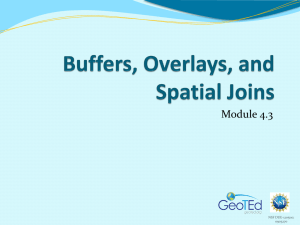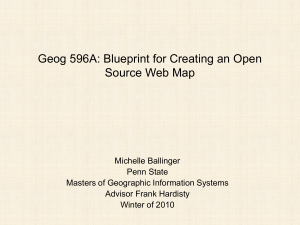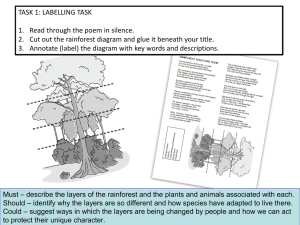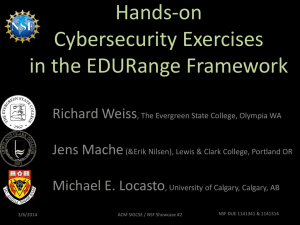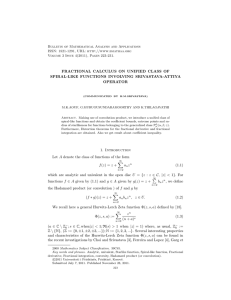ppt
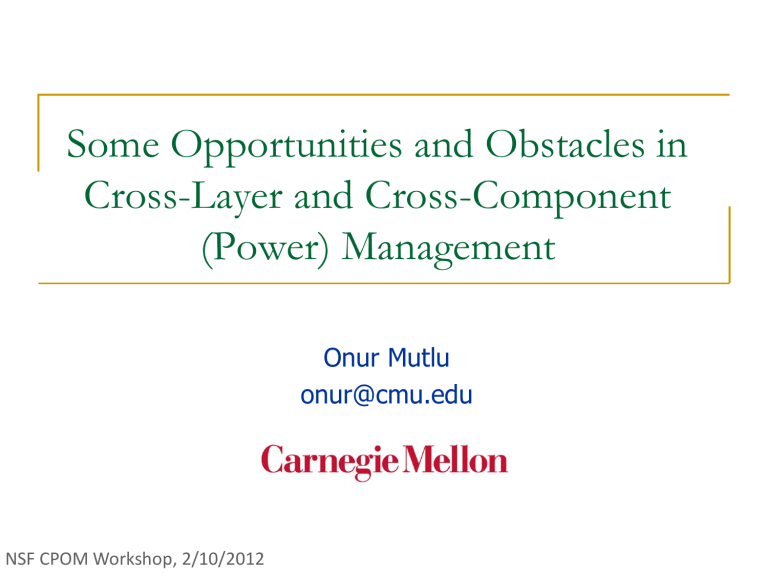
Some Opportunities and Obstacles in
Cross-Layer and Cross-Component
(Power) Management
Onur Mutlu onur@cmu.edu
NSF CPOM Workshop, 2/10/2012
What Are These Layers and Components?
Problem
Algorithm
Program/Language User
Runtime System
(VM, OS, MM)
ISA
Microarchitecture
Logic
Circuits
Electrons
Computation
Communication
Storage/Memory
Well-defined (mostly) interfaces between transformation layers and components/resources create abstractions
NSF CPOM Workshop, 2/10/2012
2
Layers and Components: Pros and Cons
Advantages of abstraction layers
Improved productivity at each layer/component
No need to worry about decisions made in higher/lower levels
Designer sanity
Disadvantages
Runtime System
(VM, OS, MM)
Overall suboptimal design
Microarchitecture
Uncoordinated decisions contradict each other, degrade efficiency
3
NSF CPOM Workshop, 2/10/2012
An Example: Lack of OS-Architecture Coordination
High OS-level priority
Low OS-level priority
(Core 0) (Core 1)
Moscibroda and Mutlu, “ Memory performance attacks: Denial of memory service in multi-core systems , ” USENIX Security 2007.
NSF CPOM Workshop, 2/10/2012
4
Layers and Components: Pros and Cons
Advantages of abstraction layers
Improved productivity at each layer/component
No need to worry about decisions made in higher/lower levels
Designer sanity
Disadvantages
Runtime System
(VM, OS, MM)
Computation
Communication
Overall suboptimal design
Microarchitecture Storage/Memory
Uncoordinated decisions contradict each other, degrade efficiency
Waste due to overprovisioning at each level
System-level metrics hard to optimize
Application-level QoS, user experience, TCO, total energy, …
Minimize energy while satisfying QoS
Research question: How do we eliminate disadvantages without sacrificing the advantages of layers?
NSF CPOM Workshop, 2/10/2012
5
One General Problem
Local optimizations relatively easy to think of; local metrics easy to optimize
Global optimization much less so
We may be lacking layers to unifying principles that span across
Coordinate information flow and policies across layers
Guide/ease the co-design and management of resources within and across layers
6
NSF CPOM Workshop, 2/10/2012
How Do We Fix The Problem?
Find and employ cross-cutting (unifying) design and resource management principles
Ensure these principles are conveyed in the interfaces
Design and enhance interfaces (driven by principles)
E.g., the application-OS-architecture interface for resource management
Develop design tools to enable global optimization
Cross-layer evaluation infrastructures
Change mentality
Be open-minded to proposals that co-design multiple layers
Performance- vs energy- vs user-centric design
Provide commensurate focus on important subsystems: memory and interconnect develop new execution models
NSF CPOM Workshop, 2/10/2012
7
Interconnect Energy Scaling
Chart courtesy of Shekhar Borkar, Intel
NSF CPOM Workshop, 2/10/2012
8
One Unifying Principle: Criticality/Slack
Dynamically identify critical/bottleneck tasks (pieces of work) and spend most of the energy on them
Not all instructions are equally important [Fields+ ISCA’01,02]
Not all network packets are equally important [Das+ ISCA’10]
Not all useful cache blocks are equally important [Qureshi+ ISCA’06]
Not all threads are equally important [Bhattacherjee+ ISCA’09]
Not all queries are equally important
Not all applications are equally important
Create a criticality interface between layers and components
Application/compiler OS/runtime hardware
Enable ways of discovering and expressing task criticality and managing resources based on criticality/slack
9
NSF CPOM Workshop, 2/10/2012
Exploiting Criticality/Slack
Identify the criticality/slack present in each task
Convey criticality information across layers/components
Co-design the layers and resources such that they can prioritize tasks based on criticality/slack
Manage execution to minimize slack and spend little energy on non-critical tasks
NSF CPOM Workshop, 2/10/2012
Identify bottleneck threads that cause serialization and dynamically ship them to high-power high-performance cores
[Suleman+ ASPLOS ’09, Joao+ ASPLOS’12]
10
Exploiting Dynamic Criticality: Other Examples
Identify critical instructions and execute them in fast pipelines [Fields+ ISCA’02]
Identify critical threads and slow down others [Bhattacherjee+
ISCA’09]
Identify critical/limiter threads in a parallel application and prioritize them in the memory controller [Ebrahimi+ MICRO’11]
Identify latency-sensitive applications/threads and prioritize them in the memory controller [Kim+ MICRO’10] or entire shared memory system [Ebrahimi+ ASPLOS’10]
Identify critical interconnect requests from core’s point of view and prioritize them in routers [Das+ ISCA’10]
11
NSF CPOM Workshop, 2/10/2012
Thread Cluster Memory Scheduling
[Kim+ MICRO’10]
1. Group threads into two clusters
2. Prioritize non-intensive cluster
3. Different policies for each cluster
Memory-non-intensive
Non-intensive cluster higher priority thread
Throughput thread Prioritized higher priority thread thread
Threads in the system
Memory-intensive
TCM, a heterogeneous scheduling policy,
Intensive cluster
Fairness
12
Other Unifying Principles and Research Issues
Consolidate many tasks to maximize efficiency and provide the QoS each task needs
QoS interface across layers
Application OS/runtime architecture uarch.
Coordinate the management of shared resources across components and layers
Goal: no efficiency loss due to contradictions in policies
Policy co-design (e.g., between cores, interconnect, memory controllers, memory): criticality can again help here
Exploit heterogeneity at all layers
Both architectural/microarchitectural and technology heterogeneity can provide large efficiency gains
13
NSF CPOM Workshop, 2/10/2012
Role of Education and Funding
We need to break the layers in education first, to be truly successful
Cross-layer undergraduate courses
Fund both within-layer and cross-layer approaches
Fund widely many areas – there is likely no silver bullet
14
NSF CPOM Workshop, 2/10/2012
Some Opportunities and Obstacles in
Cross-Layer and Cross-Component
(Power) Management
Onur Mutlu onur@cmu.edu
NSF CPOM Workshop, 2/10/2012

